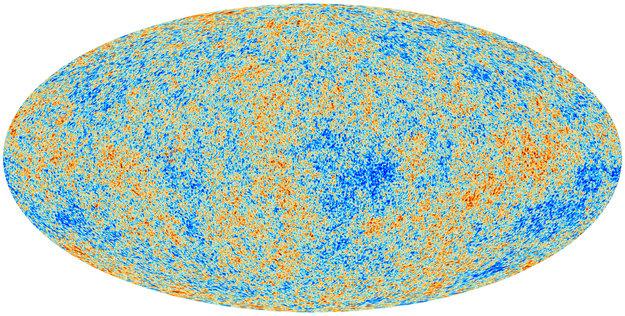
A new view of the cosmic microwave background , as seen over the whole sky with the Planck satellite. Although analyses of this image indicate complete agreement with the simple model of a big bang inflation, a new paper suggests the agreement is so perfect that it is very unlikely the inflation model is actually the correct one.
The universe was created about fourteen billion years ago in a blaze of light known as the big bang. After about 380,000 years or so, once matter had cooled enough for neutral atoms (mostly hydrogen atoms) to form, light was able to travel through space relatively freely. We see that light today as the cosmic microwave background radiation (CMBR).
The light is extremely uniform across the sky, but not perfectly so: Astronomers have discovered that the radiation actually has very faint ripples and bumps in it at a level of only about one part in ten
thousand. These ripples reflect the architecture of the universe when the light was freed, and are the cosmic seeds for subsequent cosmic structures, like galaxies.
The CMBR was discovered by Penzias and Wilson in 1964. Those faint ripples were first spotted by the NASA’s COBE satellite in 1991, and they have been studied in increasing detail during the past decade with NASA’s WMAP satellite (as well as with millimeter ground-based
telescopes). Last month, the European Space Agency announced the first
results from its Planck satellite, launched in 2009 to study the CMBR with greater precision than ever before. They reported excellent agreement with current models, and updated some of the key values, for
example finding that the age of the universe is 13.82 billion years. But the precisions of WMAP and especially Planck allow astronomers to think about more than just how galaxies developed after the matter cooled. They enable consideration of what happened in the invisible era,
before the matter had cooled. The pivotal event of that epoch is thought to have occurred right at the start, within less than a fraction of the first second: inflation.
According to models of inflation proposed in the 1980’s, based on concepts in elementary particle physics, the early universe underwent a dramatic and exponential growth spurt, swelling in size a trillion trillion trillion times. The power of this theory is that it explains many otherwise mysterious properties of the universe; for example, why distant regions located in opposite directions of space seem to be so very similar (and likewise, why do the CMBR ripples look everywhere so extremely similar to one another)? After all, the regions might be so far apart (both then and now) that they should have matured in completely independent ways? Inflation provides a solution by starting them all off rather close together and only then, somewhat later, pushing them quickly very far apart. The ideas of inflation have been constantly refined over the decades and numerous variations have been elaborated. The new Planck measurements seem to lend support.
Or maybe not. CfA astronomers Anna Ijjas, Paul Steinhardt, and Avi Loeb have just published a paper arguing that the new Planck results, far from lending credibility to ideas of inflation, actually undermine them. Indeed, they argue that they pose a challenge to cosmology overall. The scientists point out that the results of Planck are actually too good, because they disfavor the simplest versions of inflation and favor with high precision only a very particular version. Yet, they argue, if one accepts the most basic principles of the inflationary paradigm, this particular version is, actually a very unlikely compared to the simplest. For this and other reasons all related to the new Planck data, the whole edifice of inflation may be in trouble. There are alternative ideas that have been proposed over the years to inflation. Perhaps the new Planck results and the criticisms in this new paper will prompt some provocative new reconsideration of modern cosmology.